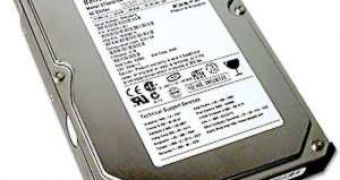While hard disk drives are not making much progress in the performance areas like reading and writing speeds, seek times and so on, hard drives manufacturers are gaining ground in the storage capacity department. It's been a long way from the first megabyte sized hard disk drive to the latest 1TB sized drive. Laptop hard disk drives are usually smaller in raw performance and storage capacity because they must operate in a moving environment, where power and safety constraints come before the best possible read or write speed. Their storage capacity is not great either, only nowadays coming closer to the capacity of desktop intended drives.
Well, at least in the storage capacity department, things are going to be a little shaky for a while, more so since the Japanese hardware manufacturer Fujitsu is expected to announce this week its innovative way of data storage that could lead to the construction - by 2010 - of laptop targeted hard disk drives with a capacity as great as 1.2TB. The technology needed for this huge storage capacity crammed on a 2.3 inch platter consists of ideally "ordered" alumina nanohole patterns that allows for isolated recordings at bit level. According to Fujitsu, cited by the news site PCWorld, the company has been able to perform basic read and write operations on a platter that uses the nanohole technology, by means of a typical hard drive recording head. Joel Hagberg, vice president of business development at Fujitsu Computer Products of America, says that this breakthrough could push the company into producing disk drives for laptops in the 2.5 inch form factor with 2 platters and 1.2TB storage capacity.
While Fujitsu was the main sponsor of research related to the ideally ordered alumina nanohole patterned media, this technology is by no means a proprietary solution as researchers from Kanagawa Academy of Science and Technology participated too. This storing media technology was created using a Perpendicular Magnetic Recording (PMR for short) process using already existent techniques like nano-imprint lithography, anodic oxidation and cobalt electrodeposition.
As traditionally, 2.5 inch laptop hard disk drives need less power to operate and are cooler and more silent than their desktop counterparts that still have the capacity and performance benefits, more and more computer hardware manufacturers are looking for ways of combining those traits, according to John Rydning, an analyst at Framingham, Mass.-based IDC.
"[Fujitsu's achievement] allows especially the smaller form factors to reach pretty high capacities. From a business-requirement standpoint, one advantage that brings is the opportunity to use smaller drives for applications, and smaller drives tend to use less power," Rydning explained. "That kind of technology is definitely what's needed to get [improved storage] requirements."

 14 DAY TRIAL //
14 DAY TRIAL //